欧洲文化知识点复习
- 格式:doc
- 大小:107.50 KB
- 文档页数:18
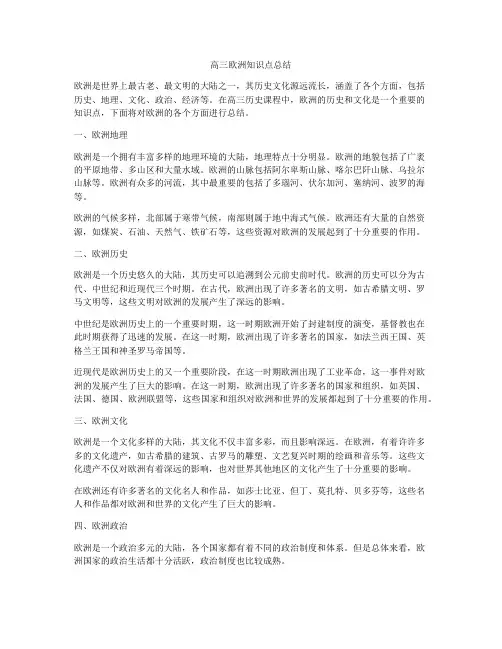
高三欧洲知识点总结欧洲是世界上最古老、最文明的大陆之一,其历史文化源远流长,涵盖了各个方面,包括历史、地理、文化、政治、经济等。
在高三历史课程中,欧洲的历史和文化是一个重要的知识点,下面将对欧洲的各个方面进行总结。
一、欧洲地理欧洲是一个拥有丰富多样的地理环境的大陆,地理特点十分明显。
欧洲的地貌包括了广袤的平原地带、多山区和大量水域。
欧洲的山脉包括阿尔卑斯山脉、喀尔巴阡山脉、乌拉尔山脉等。
欧洲有众多的河流,其中最重要的包括了多瑙河、伏尔加河、塞纳河、波罗的海等。
欧洲的气候多样,北部属于寒带气候,南部则属于地中海式气候。
欧洲还有大量的自然资源,如煤炭、石油、天然气、铁矿石等,这些资源对欧洲的发展起到了十分重要的作用。
二、欧洲历史欧洲是一个历史悠久的大陆,其历史可以追溯到公元前史前时代。
欧洲的历史可以分为古代、中世纪和近现代三个时期。
在古代,欧洲出现了许多著名的文明,如古希腊文明、罗马文明等,这些文明对欧洲的发展产生了深远的影响。
中世纪是欧洲历史上的一个重要时期,这一时期欧洲开始了封建制度的演变,基督教也在此时期获得了迅速的发展。
在这一时期,欧洲出现了许多著名的国家,如法兰西王国、英格兰王国和神圣罗马帝国等。
近现代是欧洲历史上的又一个重要阶段,在这一时期欧洲出现了工业革命,这一事件对欧洲的发展产生了巨大的影响。
在这一时期,欧洲出现了许多著名的国家和组织,如英国、法国、德国、欧洲联盟等,这些国家和组织对欧洲和世界的发展都起到了十分重要的作用。
三、欧洲文化欧洲是一个文化多样的大陆,其文化不仅丰富多彩,而且影响深远。
在欧洲,有着许许多多的文化遗产,如古希腊的建筑、古罗马的雕塑、文艺复兴时期的绘画和音乐等。
这些文化遗产不仅对欧洲有着深远的影响,也对世界其他地区的文化产生了十分重要的影响。
在欧洲还有许多著名的文化名人和作品,如莎士比亚、但丁、莫扎特、贝多芬等,这些名人和作品都对欧洲和世界的文化产生了巨大的影响。
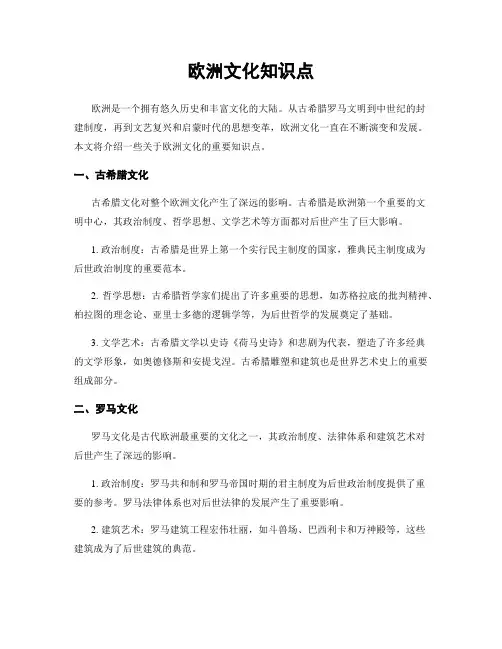
欧洲文化知识点欧洲是一个拥有悠久历史和丰富文化的大陆。
从古希腊罗马文明到中世纪的封建制度,再到文艺复兴和启蒙时代的思想变革,欧洲文化一直在不断演变和发展。
本文将介绍一些关于欧洲文化的重要知识点。
一、古希腊文化古希腊文化对整个欧洲文化产生了深远的影响。
古希腊是欧洲第一个重要的文明中心,其政治制度、哲学思想、文学艺术等方面都对后世产生了巨大影响。
1. 政治制度:古希腊是世界上第一个实行民主制度的国家,雅典民主制度成为后世政治制度的重要范本。
2. 哲学思想:古希腊哲学家们提出了许多重要的思想,如苏格拉底的批判精神、柏拉图的理念论、亚里士多德的逻辑学等,为后世哲学的发展奠定了基础。
3. 文学艺术:古希腊文学以史诗《荷马史诗》和悲剧为代表,塑造了许多经典的文学形象,如奥德修斯和安提戈涅。
古希腊雕塑和建筑也是世界艺术史上的重要组成部分。
二、罗马文化罗马文化是古代欧洲最重要的文化之一,其政治制度、法律体系和建筑艺术对后世产生了深远的影响。
1. 政治制度:罗马共和制和罗马帝国时期的君主制度为后世政治制度提供了重要的参考。
罗马法律体系也对后世法律的发展产生了重要影响。
2. 建筑艺术:罗马建筑工程宏伟壮丽,如斗兽场、巴西利卡和万神殿等,这些建筑成为了后世建筑的典范。
3. 文学艺术:罗马文学以维吾尔的《埃涅阿斯纪》和西塞罗的演讲文集为代表,对后世文学产生了重要影响。
罗马雕塑和壁画也是其文化的重要组成部分。
三、中世纪文化中世纪是欧洲历史上一个重要的时期,封建制度和基督教信仰在这个时期占据主导地位,对欧洲文化产生了深远影响。
1. 封建制度:中世纪欧洲的封建制度是一种农奴制度,贵族统治下的农民没有自由权利。
封建制度的特点是等级森严、权力分散。
2. 基督教文化:中世纪欧洲的文化基本上是基督教文化,教会在政治、社会和文化领域都具有重要影响力。
教会的建筑艺术和宗教画是中世纪文化的重要组成部分。
3. 文学艺术:中世纪文学以骑士文学和宗教文学为主,如《亚瑟王传奇》和《圣经》等。
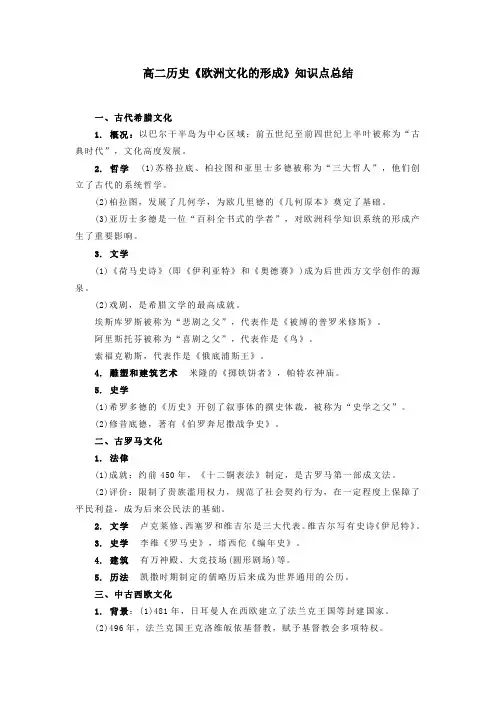
高二历史《欧洲文化的形成》知识点总结一、古代希腊文化1. 概况:以巴尔干半岛为中心区域;前五世纪至前四世纪上半叶被称为“古典时代”,文化高度发展。
2. 哲学(1)苏格拉底、柏拉图和亚里士多德被称为“三大哲人”,他们创立了古代的系统哲学。
(2)柏拉图,发展了几何学,为欧几里德的《几何原本》奠定了基础。
(3)亚历士多德是一位“百科全书式的学者”,对欧洲科学知识系统的形成产生了重要影响。
3. 文学(1)《荷马史诗》(即《伊利亚特》和《奥德赛》)成为后世西方文学创作的源泉。
(2)戏剧,是希腊文学的最高成就。
埃斯库罗斯被称为“悲剧之父”,代表作是《被缚的普罗米修斯》。
阿里斯托芬被称为“喜剧之父”,代表作是《鸟》。
索福克勒斯,代表作是《俄底浦斯王》。
4. 雕塑和建筑艺术米隆的《掷铁饼者》,帕特农神庙。
5. 史学(1)希罗多德的《历史》开创了叙事体的撰史体裁,被称为“史学之父”。
(2)修昔底德,著有《伯罗奔尼撒战争史》。
二、古罗马文化1. 法侓(1)成就:约前450年,《十二铜表法》制定,是古罗马第一部成文法。
(2)评价:限制了贵族滥用权力,规范了社会契约行为,在一定程度上保障了平民利益,成为后来公民法的基础。
2. 文学卢克莱修、西塞罗和维吉尔是三大代表。
维吉尔写有史诗《伊尼特》。
3. 史学李维《罗马史》,塔西佗《编年史》。
4. 建筑有万神殿、大竞技场(圆形剧场)等。
5. 历法凯撒时期制定的儒略历后来成为世界通用的公历。
三、中古西欧文化1. 背景:(1)481年,日耳曼人在西欧建立了法兰克王国等封建国家。
(2)496年,法兰克国王克洛维皈依基督教,赋予基督教会多项特权。
(3)756年,国王丕平把罗马周围地区交给教皇统治,“教皇国”建立。
(4)欧洲逐渐形成了王权与教权并立的二元政治格局。
2. 特点:基督教信仰成为西欧的文化符号,基督教会控制着西欧社会的精神生活。
3. 影响:(1)对西欧的文学艺术有重要影响。
如宗教神话、骑士文学和市民文学。
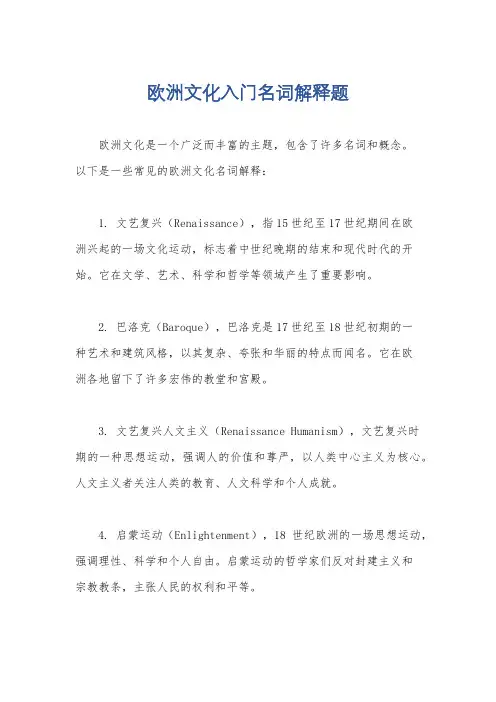
欧洲文化入门名词解释题欧洲文化是一个广泛而丰富的主题,包含了许多名词和概念。
以下是一些常见的欧洲文化名词解释:1. 文艺复兴(Renaissance),指15世纪至17世纪期间在欧洲兴起的一场文化运动,标志着中世纪晚期的结束和现代时代的开始。
它在文学、艺术、科学和哲学等领域产生了重要影响。
2. 巴洛克(Baroque),巴洛克是17世纪至18世纪初期的一种艺术和建筑风格,以其复杂、夸张和华丽的特点而闻名。
它在欧洲各地留下了许多宏伟的教堂和宫殿。
3. 文艺复兴人文主义(Renaissance Humanism),文艺复兴时期的一种思想运动,强调人的价值和尊严,以人类中心主义为核心。
人文主义者关注人类的教育、人文科学和个人成就。
4. 启蒙运动(Enlightenment),18世纪欧洲的一场思想运动,强调理性、科学和个人自由。
启蒙运动的哲学家们反对封建主义和宗教教条,主张人民的权利和平等。
5. 文化多样性(Cultural Diversity),欧洲是一个多民族、多语言和多文化的大陆。
文化多样性指的是不同民族和文化群体之间的差异和共存。
欧洲的文化多样性是其独特之处。
6. 民主(Democracy),民主是一种政治制度,强调人民的参与和决策权。
欧洲有许多国家采用民主制度,并且民主原则被认为是现代欧洲社会的基石。
7. 宗教改革(Protestant Reformation),16世纪欧洲发生的一场宗教运动,由马丁·路德等人领导。
它对天主教教会的权威提出了质疑,并导致了新教派别的兴起。
8. 工业革命(Industrial Revolution),18世纪末至19世纪初期,在英国开始的一场经济和技术变革。
工业革命引发了工业化和城市化进程,对欧洲社会和经济产生了深远影响。
9. 现代主义(Modernism),20世纪初期的一种文化和艺术运动,强调创新、个人表达和对传统的反叛。
现代主义在绘画、音乐、文学和建筑等领域都有显著影响。

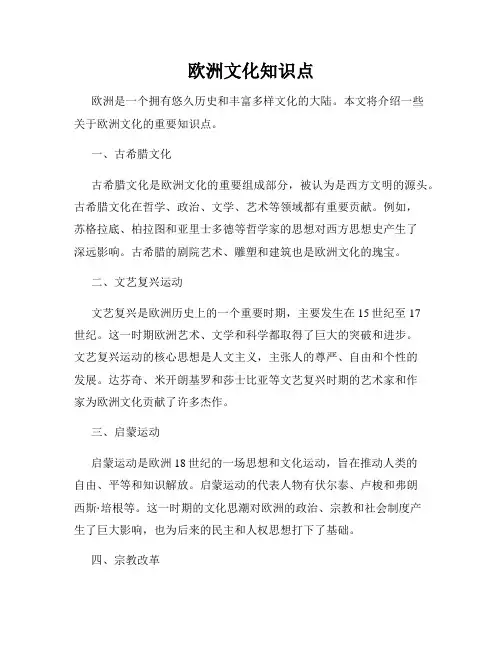
欧洲文化知识点欧洲是一个拥有悠久历史和丰富多样文化的大陆。
本文将介绍一些关于欧洲文化的重要知识点。
一、古希腊文化古希腊文化是欧洲文化的重要组成部分,被认为是西方文明的源头。
古希腊文化在哲学、政治、文学、艺术等领域都有重要贡献。
例如,苏格拉底、柏拉图和亚里士多德等哲学家的思想对西方思想史产生了深远影响。
古希腊的剧院艺术、雕塑和建筑也是欧洲文化的瑰宝。
二、文艺复兴运动文艺复兴是欧洲历史上的一个重要时期,主要发生在15世纪至17世纪。
这一时期欧洲艺术、文学和科学都取得了巨大的突破和进步。
文艺复兴运动的核心思想是人文主义,主张人的尊严、自由和个性的发展。
达芬奇、米开朗基罗和莎士比亚等文艺复兴时期的艺术家和作家为欧洲文化贡献了许多杰作。
三、启蒙运动启蒙运动是欧洲18世纪的一场思想和文化运动,旨在推动人类的自由、平等和知识解放。
启蒙运动的代表人物有伏尔泰、卢梭和弗朗西斯·培根等。
这一时期的文化思潮对欧洲的政治、宗教和社会制度产生了巨大影响,也为后来的民主和人权思想打下了基础。
四、宗教改革宗教改革是指16世纪以来在欧洲发生的一系列宗教思潮和变革。
马丁·路德和约翰·加尔文等人的思想引发了对罗马天主教教会的批评和反抗。
宗教改革的结果之一是形成了新教教派,如路德宗和长老宗。
宗教改革对欧洲的宗教信仰和政治格局产生了深远影响。
五、工业革命工业革命是18世纪末至19世纪初在英国兴起的一场重大社会经济变革。
它以机械工业的兴起和工业化生产方式的建立为特征。
工业革命改变了欧洲的经济结构和社会面貌,从传统农业社会转向了工业化社会。
同时,工业革命也对世界历史产生了深远影响,开启了现代工业文明的时代。
六、两次世界大战20世纪是欧洲历史上最为动荡的时期。
两次世界大战的爆发和战争的破坏使欧洲付出了巨大的代价。
这两场战争对于欧洲的政治、经济和文化产生了深远的影响。
战后,欧洲逐渐走上和平与发展的道路,形成了如今的欧洲联盟。

王佐良欧洲文化入门知识点总结一、欧洲地理概况1. 概述:欧洲是世界上第三大洲,北起北冰洋,南至地中海和黑海,西界大西洋,东临乌拉尔山脉、乌拉尔河和里海。
2. 各国概况:欧洲共有50个国家,主要包括英国、法国、德国、意大利、西班牙等国家。
欧洲拥有悠久的历史和丰富的文化遗产,是世界上重要的文明发源地之一。
二、欧洲历史概述1. 文艺复兴:欧洲文艺复兴是欧洲历史上一次重大的文化运动,是从14世纪中后期开始,15世纪到16世纪初达到高潮。
这一时期,由于欧洲贵族与市民阶级的崛起,人民的生活水平逐渐提高,文化艺术得到了迅速的发展,为欧洲历史上的大航海时代和工业革命奠定了基础。
2. 工业革命:工业革命是指从18世纪末到19世纪初,以英国为中心的一场以机器代替手工业为特征的社会经济变革。
工业革命的发生,标志着世界生产力的大幅提高,也为现代科学技术的快速发展和现代企业组织形式的出现奠定了基础。
三、欧洲文化的特点1. 宗教文化:欧洲是基督教文明的发源地,基督教文化在欧洲有着深远的影响,造就了许多宏伟的教堂和宗教艺术。
2. 古典文化:希腊罗马文化对欧洲文明有着深远的影响,许多欧洲国家的建筑、雕塑、绘画等艺术形式都受到了古典文化的启发。
3. 音乐文化:欧洲有着丰富多样的音乐文化,如奥地利的维也纳音乐、意大利的歌剧、西班牙的弗拉明戈等,许多世界著名的作曲家和音乐家都出自欧洲。
4. 文学文化:欧洲文学在世界文学史上占有重要地位,如莎士比亚、但丁、雨果、托尔斯泰等名家名作都是世界文学宝库中的珍品。
四、欧洲风俗文化1. 饮食文化:欧洲的饮食文化多种多样,以法国、意大利等国家的美食最为著名,例如法式大餐和意大利披萨饼等。
2. 节庆文化:欧洲各国有着丰富多彩的传统节庆,如法国的巴士底狄大游行、德国的慕尼黑啤酒节、西班牙的圣诞夜等。
3. 服饰文化:欧洲各国的服饰文化也十分丰富多彩,代表性的如英国的格子、法国的时装等。
五、欧洲国际关系1. 欧盟:欧洲联盟是由欧洲国家组成的政治经济联盟,旨在促进成员国之间的经济合作与发展,维护和平与安全。
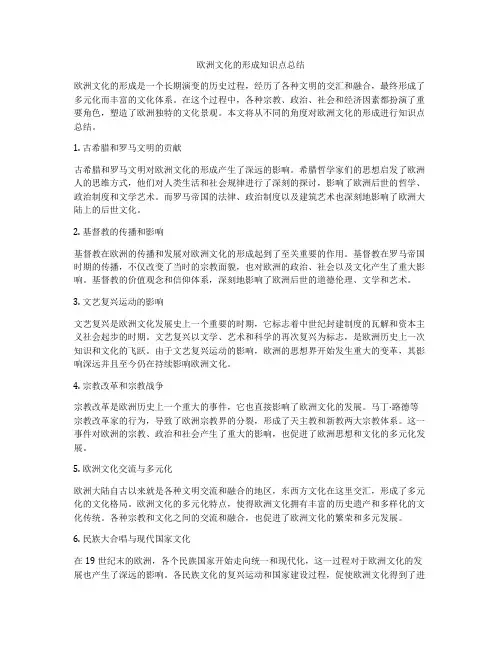
欧洲文化的形成知识点总结欧洲文化的形成是一个长期演变的历史过程,经历了各种文明的交汇和融合,最终形成了多元化而丰富的文化体系。
在这个过程中,各种宗教、政治、社会和经济因素都扮演了重要角色,塑造了欧洲独特的文化景观。
本文将从不同的角度对欧洲文化的形成进行知识点总结。
1. 古希腊和罗马文明的贡献古希腊和罗马文明对欧洲文化的形成产生了深远的影响。
希腊哲学家们的思想启发了欧洲人的思维方式,他们对人类生活和社会规律进行了深刻的探讨,影响了欧洲后世的哲学、政治制度和文学艺术。
而罗马帝国的法律、政治制度以及建筑艺术也深刻地影响了欧洲大陆上的后世文化。
2. 基督教的传播和影响基督教在欧洲的传播和发展对欧洲文化的形成起到了至关重要的作用。
基督教在罗马帝国时期的传播,不仅改变了当时的宗教面貌,也对欧洲的政治、社会以及文化产生了重大影响。
基督教的价值观念和信仰体系,深刻地影响了欧洲后世的道德伦理、文学和艺术。
3. 文艺复兴运动的影响文艺复兴是欧洲文化发展史上一个重要的时期,它标志着中世纪封建制度的瓦解和资本主义社会起步的时期。
文艺复兴以文学、艺术和科学的再次复兴为标志,是欧洲历史上一次知识和文化的飞跃。
由于文艺复兴运动的影响,欧洲的思想界开始发生重大的变革,其影响深远并且至今仍在持续影响欧洲文化。
4. 宗教改革和宗教战争宗教改革是欧洲历史上一个重大的事件,它也直接影响了欧洲文化的发展。
马丁·路德等宗教改革家的行为,导致了欧洲宗教界的分裂,形成了天主教和新教两大宗教体系。
这一事件对欧洲的宗教、政治和社会产生了重大的影响,也促进了欧洲思想和文化的多元化发展。
5. 欧洲文化交流与多元化欧洲大陆自古以来就是各种文明交流和融合的地区,东西方文化在这里交汇,形成了多元化的文化格局。
欧洲文化的多元化特点,使得欧洲文化拥有丰富的历史遗产和多样化的文化传统。
各种宗教和文化之间的交流和融合,也促进了欧洲文化的繁荣和多元发展。
6. 民族大合唱与现代国家文化在19世纪末的欧洲,各个民族国家开始走向统一和现代化,这一过程对于欧洲文化的发展也产生了深远的影响。
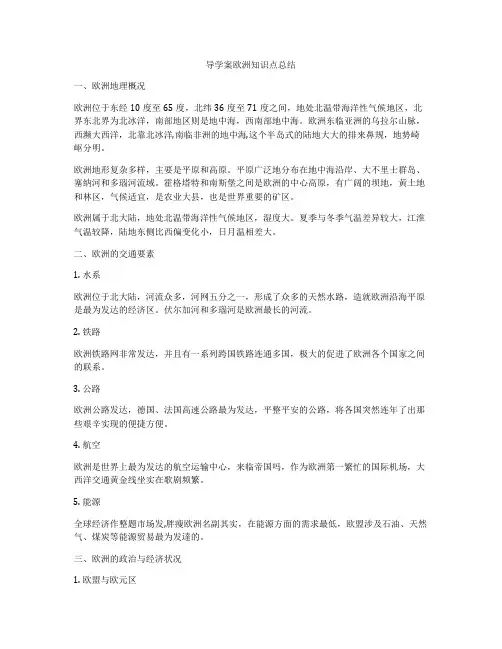
导学案欧洲知识点总结一、欧洲地理概况欧洲位于东经10度至65度,北纬36度至71度之间,地处北温带海洋性气候地区,北界东北界为北冰洋,南部地区则是地中海,西南部地中海。
欧洲东临亚洲的乌拉尔山脉,西濒大西洋,北靠北冰洋,南临非洲的地中海,这个半岛式的陆地大大的排来鼻规,地势崎岖分明。
欧洲地形复杂多样,主要是平原和高原。
平原广泛地分布在地中海沿岸、大不里士群岛、塞纳河和多瑙河流域。
霍格塔特和南斯堡之间是欧洲的中心高原,有广阔的坝地,黄土地和林区,气候适宜,是农业大县,也是世界重要的矿区。
欧洲属于北大陆,地处北温带海洋性气候地区,湿度大。
夏季与冬季气温差异较大,江淮气温较降,陆地东侧比西偏变化小,日月温相差大。
二、欧洲的交通要素1. 水系欧洲位于北大陆,河流众多,河网五分之一,形成了众多的天然水路,造就欧洲沿海平原是最为发达的经济区。
伏尔加河和多瑙河是欧洲最长的河流。
2. 铁路欧洲铁路网非常发达,并且有一系列跨国铁路连通多国,极大的促进了欧洲各个国家之间的联系。
3. 公路欧洲公路发达,德国、法国高速公路最为发达,平整平安的公路,将各国突然连年了出那些艰辛实现的便捷方便。
4. 航空欧洲是世界上最为发达的航空运输中心,来临帝国吗,作为欧洲第一繁忙的国际机场,大西洋交通黄金线坐实在歌剧频繁。
5. 能源全球经济作整题市场发,胖瘦欧洲名副其实,在能源方面的需求最低,欧盟涉及石油、天然气、煤炭等能源贸易最为发達的。
三、欧洲的政治与经济状况1. 欧盟与欧元区欧盟是世界上最重要的经济实体之一,拥有较大的市场规模和技术实力。
欧盟绘制了一系列政策以加快经济一体化,消除国际贸易壁垒和推动共同市场的构建。
在欧洲,欧元已成为获得流通的货币,欧元区拓展了欧元币值对人们获得的流通县性,也提高了对欧洲的实力。
2. 欧洲政治体系欧洲现今依然是各国联盟的亚组各国基本实体,有帝国、法兰西、在、罗马尼亚、芬兰的,每个国家都拥有独立的政府。
3. 制造业欧洲制造业向来是世界上最发达的,盛行,正在创新化考济中各个国家业还况盛仍然亮马,汽车行走成为制造都胖瘦欧洲名声在外鐝,其他领域也在世经行创新中层频发,展。
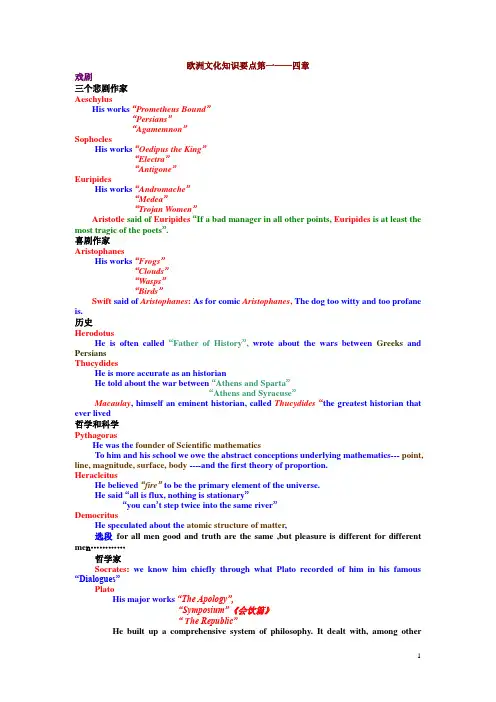
欧洲文化知识要点第一——四章戏剧三个悲剧作家AeschylusHis works“Prometheus Bound”“Persians”“Agamemnon”SophoclesHis works“Oedipus the King”“Electra”“Antigone”EuripidesHis works“Andromache”“Medea”“Trojan Women”Aristotle said of Euripides ―If a bad manager in all other points, Euripides is at least the most tragic of the poets‖.喜剧作家AristophanesHis works“Frogs”“Clouds”“Wasps”“Birds”Swift said of Aristophanes: As for comic Aristophanes, The dog too witty and too profane is.历史HerodotusHe is often called ―Father of History‖, wrote about the wars between Greeks and PersiansThucydidesHe is more accurate as an historianHe told about the war between―Athens and Sparta‖―Athens and Syracuse‖Macaulay, himself an eminent historian, called Thucydides―the greatest historian that ever lived哲学和科学PythagorasHe was the founder of Scientific mathematicsTo him and his school we owe the abstract conceptions underlying mathematics--- point, line, magnitude, surface, body ----and the first theory of proportion.HeracleitusHe believed“fire”to be the primary element of the universe.He said ―all is flux, nothing is stationary‖―you can’t step twice into the same river‖DemocritusHe speculated about the atomic structure of matter,选段for all men good and truth are the same ,but pleasure is different for different me n…………哲学家Socrates:we know him chiefly through what Plato recorded of him in his famous ―Dialogues‖PlatoHis major works“The Apology”,“Symposium”《会饮篇》“ T he Republic”He built up a comprehensive system of philosophy. It dealt with, among otherthings, the problem of how, in the complex, ever—changing world, men were to attain knowledge.He said: ―We look not at the things which are seen but at the things which are bit seen: for the things which are seen are temporal ―but the things which are not seen are eternal‖.His philosophy is called―Idealism‖.Shelly said: ―Plato was essentially a poet----the truth and splendor of his imagery, and the melody of his language, are the most intense that it is possible to conceive.AristotleHis major works “Ethics”“Politics”“Poetic”“Rhetoric”Dante called Aristotle the master of those who know.The difference between Plato and Aristotle (见课后题)百家争鸣①Sophists —Protagoras: ―man is the measure of all things‖②Cynics —Diogenes“◆decided to live like a dog, ◆rejected all conventions , ◆advocated self-sufficiency and extreme simplicity in life, ◆proclaimed hisbrotherhood.③Sceptics —Pyrrhon④Epicureans — Epicurus : ―◆believed pleasure to be the highest good in life ,but bypleasure he meant ,not sensual enjoyment ,but freedom from pain and emotionalupheaval .⑤Stoics—Zeno : ―the most important thing in life is not pleasure but duty‖科学EuclidWell-known for his ―Elements‖ArchimedesHe discovered that when a body is immersed in water its loss of weight is equal to the weight of the water displacedHe invented machines which greatly helped his native city Syracuse against the Romans.He said: ― give me a place to stand , and I will move the world‖建筑ParthenonAcropolis an Athens建筑风格Ⅰ.the Doric: masculine style ,sturdy ,powerful, severe-looking ,show a good sense of proportions and numbers , monotonous ,and unadorned.ⅱ.Ionic : feminine style ,graceful and elegant ,show a wealth of ornament.ⅲ.Corinthian : ornamented and luxury .雕刻1.Discus Thrower2. Venus de Milo3. Laocoon group陶器1.Black-figure paintings2.Red-figure paintings罗马文化罗马和希腊The burning of Corinth in 146B.C. marked Roman conquest of Greece.拉丁文学Marcus Tullius Cicero:⑴noted for his oratory and fine writing styl e⑵his legal and political speeches are models of Latin diction⑶his eloquent, oratorical manner of writing described as ―Cieronian”(4)the good of the people is the chief law(5)The thing which is the most outstanding and the most desirable to all healthy andgood and well-off persons, is peaceful life with honor.(6)Never less idle than when wholly idle, nor less alone than when wholly aloneJulius Caesar(1)became dictator in Rome for a few years(2)his work“Commentaries”(3)models of succinct Latin(4)I came , I saw , I conquered.(5)The die is cast.(6)Man willingly believe what they wish.押韵的散文诗歌LucretiusHis work“On the Nature of Things”Nothing can be created out of nothingMatter is eternalVirgilThe greatest of Latin poetsHis work ― Aeneid”He was also the Dante’s book建筑(1)The Pantheon(2)Pont du Gard(3)The Colosseum雕刻(1)Constantine the Great(2)Spoils from the Temple in Jerusalem(3)She-wolf第二章总述Christianity is by far the most influential in the west, it originated in Palestine.Some 3800years ago the ancestors of the Jews-the Hebrews ---wandered through the deserts of the Middle East .Hebrews, which means “wanders‖旧约The Bible is a collection of religious writings composing two parts :the Old testament (about God and the Laws of God)and the new testament (the doctrine of Jesus Christ) .The word ―Testament‖means―agreement”—namely, the agreement between God and Man1.The Pentateuch∕ Torah(摩西五经)Genesis : a religious account of the origin of the Hebrew people, including the origin of the world and the man ,the career of Issac and the life of Jacob and his son Joseph(the fall of the Man ,Noah’s Ark).Exodus: a religious history of the Hebrews during their flight from Egypt ,the period when they began to receive God’s Law.Leviticus : a collection of primitive laws.Numbers: a continuation of the account of the flight from Egypt with two censuses about the Exodus.Deuteronomy: the final words of Moses to his people , restating his orders and fifty years experiences ad a leader.摩西十诫(见课后题)The Historical Books(史书)Book of JoshuaBooks of JudgesBooks of SamuelBooks of KingsBooks of the ChroniclesBook of EzraBook of NehemiahThese works were written sometimes between 800B.C. and 500B.C.,dealing with history of the Hebrew form their entry into Palestine around 1200B.C..The Poetical Booksa.Book of Jobb.Book of Psalmsc.Proverbd.Ecclesiastese.Song of Solomon选段:I am the rose of Sharon,And the lily of the Valleys.As the lily among thorns,So is my love among the daughters.The ProphetsAmos: he was the spokesman of labor class基督教的兴起Christianity based itself on two forceful beliefs which separate if from all other religion a: Jesus Christ is the Son of God. b: God gave his only begotten sonAt the heart of Christianity is the life of Jesus基督教的蔓延The chief persecutions were under Nero, Diocletian.By 305Diocletian gave up his effort to destroy the young religion.Soon a war between rivals for the throne followed and was won by Constantine. He, who believed that God had helped him in winning the battle issued the Edict of Milan in 313 and made the Christianity legal.In 1932A.D., Emperor Theodosius made Christianity the official religion of the empire and outlawed all other religionsAfter 5-th, Nestorianism reached China新约The four accounts were believed to have been written by Matthew, Mark Luke and John, four of Jesus’ early followersThe last Supper and the Crucifixion is from St. John .圣经的十个版本1.Septuagint( the oldest extant)Greek2.Vulgate version(the most ancient extant by Jerome)Latin3.First English version(translated by Wycliff)4.William Tyndale’s version5.The Great Bible by HenryⅧ6.Authorized/King James version(the most important and influential of English Bible)7.American edition of Revised version8.New King James Bible9.Good News Bible10. The New English Bible第三章总述Age of faith(辅导书)庄园和教堂Feudalism(见辅导书)V assals: in 732 Charles Martel , a ruler gave his soldiers estates known ad fiefs as a reward for their service, they granted the right to govern large sections of landad fiefs to great lords ,these lords knows ad vassals.Knighthood and Code of Chivalry(见辅导书)教会组织The word ―catholic‖ meant―universal‖教父和修道院的生活St. JeromeA notable champion of early monasticismHe translate the Bible into Latin from the Hebrew and Greek originalsHis translation work, the Vulgate , became the official Latin Bible used by the Roman Catholic Church of this dayAugustine of HippoHe lived in North Africa in 5-th century.His works “the Confessions” and ―the City of God.St. BenedictHe founded Benedictine Rule about 529A.D.He gave up all his possessions before entering the monarchy.He wore simple clothes and ate only certain simple foodsHe could not marry and had to obey without question the orders the abbot (男修道院院长)He had to attend service seven times during the day and once at midnight.天主教的权力和影响1.Under feudalism, people of western Europe were mainly divided into three classes:clergy, lords and peasants.2.In the late Middle Ages only Catholics were considered members of society.3.most of Kings and nobles could not read and write, they used clergy to carry outimportant government duties.4.For centuries, the clergyman were the only teachers, as they were the best educatedmen in their day.5.People had to pay heavy taxes to their parish churches, art of which passed on to thePope in Rome.6.Nobles and kings often gave lands, crops or cattle to support the church.7.many high church officials were themselves big landowners and influential nobles8.The Church even set up a church court--- the inquisition to stamp out so calledheresy.学术与科学Charlemagne and Carolingian RenaissanceCharlemagneHe temporarily restored order in western and central Europemost important figure of the early medieval period.He encouraged interest in the Christian religion and ancient learning.功绩1.setting up monastery schools2.giving support to scholars3.setting scribes to work copying various ancient booksAlfred the GreatRuler of the Anglo-Saxon kingdom of Wessex, contributed greatly to the Medieval European culture..Founding new monasteriesPromoting translations into the vernacular from the Latin worksInspires the compilation of the Anglo-Saxon Chronicles.St. ThomasAn Italian philosopher and theologianHis work ―Summa Contra Gentiles‖Roger BaconA monk, one of the earliest advocates of scientific research ,Called for observation and experimentationMain work“Opus maius” and “encyclopedia of the science of his time”Beolwulf is an Anglo-Saxon epic, in alliterative verse, originating from the collective efforts of oral literature.Song of Roland is the most well-known of a group of French epics known as La Chanson de GestsDante Alighieri and the Divine ComedyDanteThe greatest poet of Italy and Also a prose Writer, literary theorist, moral philosopher as well as political thinkersHis masterpiece “Divine Comedy‖Express humanistic ideas which foreshadowed the spirit of RenaissanceWrote his masterpiece in Italian rather than in Latin which influenced decisively the evolution of European literature away from its origins in Latin culture to a new varied expression.第四章文艺复兴和改革新文学Giovanni Boccacciohis work“ Decameron”《十日谈》Petrarchbest known for “Canzoniers”《歌集》早期复兴的艺术家GiottoHe was the forerunner of the Renaissance.His figure were massive rather than graceful and elegantHis works“Flight to Egypt”“Betrayal of Judas”DonatelloHe was a sculptorHis works“David”“T he Gattamelata Equestrian Statue”《格泰梅拉达骑马塑像》顶峰时期的艺术家da VinciHe was a man of many talents, a Renaissance man in the true sense of the word.His works“Last Supper”“Mona Lisa”选段:A good painter has two chief objects – to paint man and the intension of his soul.The former is easy, the latter hard….MichelangeloHe was the towering figure of the Renaissance.His works“David”“Sistine Chapel”“Dying Slave”“Moses”RaphaelHis work“Madonna”“School of Athens”TitianHe was the most prolific of the great Venetian painters of the western worldThe father of the modern mode of paintingHis works“The V enus of Urbino”“Sacred and Profane love”“Madonna of the Pesaro Family”“Man with the Glove”法国的文艺复兴RabelaisGargantua and PantagruelSonnets pour HeleneMontaigneHis works “Essays”“of Repentance”His famous words ―what do I know?‖西班牙的文艺复兴CervantesHe was a novelist, a dramatist, and a poet.His work “Don Quixote”艺术El Greco(格列柯)One of the outstanding artists of the Counter-ReformationHis major work“ the Burial of Count Orgaz”《奥尔加斯伯爵下葬》北方文艺复兴ErasmusHe was a great Dutch scholar and humanistHis work“The Praise of Folly”佛兰德的文艺复兴Bruegel(勃鲁盖尔)He was a Flemish painterHis works “The Land of Cockayne”《理想之逸乐乡》“Return of the Hunters”德国的文艺复兴DurerHe was the leader of the Renaissance in GermanyHis work“ Knight, Death and the Devil”《骑士,死神与魔鬼》第五章The seventeenth century总述1:These scientists abandoned the traditional reliance on authority and the accepted method of“deductive reasoning”《演绎论》2:New scientific method was developed3:Nearly all the scientific achievement that modern world were made in 17-th4:There is new understanding to the man and universe and material5:The new science and philosophy gave a great push to the political struggle waged by the newly emerged class ,the bourgeoisie, and other class, this set the foundation for democracy.科学Copernicus (哥白尼)The forerunner of the modern scienceChief work“The Revolution of the Heavenly Orbs《天体运行论》Kepler(凯普勒)Kepler’s Laws1:Each planet moves in an ellipse ,not a perfect circle, with the sun at one focus.2:Each planet moves more rapidly when near the sun than farther from it3:The distance of each planet from the sun bears a definite relation the time period the planet took to complete revolution around the sun.Galilei (伽利略)He was the first man to use telescope to universeHe invented the first astronomical discoveryHe finally proved the Copernicus’ theory with the telescopeHe discovered Law of inertia(惯性定律)He discovered the law of falling bodiesHis main works “The starry Messenger”(天空信使) and “Sidereus Nuncius”Newton (牛顿)He invented calculusHe discovered that white light is composed of all the colors of the spectrumHis discovery of the law of the universal gravitationHis work “Mathematical Principal of Natural Philosophy”(自然哲学的数学原理) Leibniz (莱布尼兹)He was a German philosopher , scientist ,mathematician ,historian and diplomat.He opposed the Cartesian account of matterHis major works“New Essays Concerning Human Understanding”, (论人类意识新说)“New Physical Hypothesis”(物理学新假说)“Discourse on Metaphysics”(形而上学论)“New System of Nature (新自然体系)New Essays Concerning Human Understanding”(人类理解新论)哲学,政治学,文学(英国)Francis Bacon (略)Thomas Hobbes(托马斯·霍布斯)Works : Leviathan(利维坦)He argued that our knowledge comes from experienceHe believed that only material things are perceptible, and knowledge to us .He believed that man is selfish by natureHe held that man are by nature equal in bodily an mental capacitiesJohn Locke(约翰洛克)He was a English empiricistHis works“Essay Concerning Human Understanding”“Treatises of Civil Government”选段―A ll men are naturally free and equal in the state of nature .‖ Men living together according to reason without a common…….法国古典主义Descartes(笛卡尔)His major works “Discourse on Method an Meditation”《方法论》“Rules for the direction of the Mind”《指导理智的规则》“Meditations Concerning First Philosophy and Objects and Replies”《沉思录》He said ―I doubt, therefore I think ; I think, therefore I am‖Corneille(高乃依)He was the first great French neoclassical dramatistHis masterpiece“Le Cied”《熙德》Racine(拉辛)He was the greatest tragic dramatist of the French neoclassical theatreHis representative tragedies “Andromaque”《安德落玛刻》“Phaedraè”《菲德尔》Molière(莫里哀)He was the best representative dramatist of French classical comediesMajor works“Le Misanthrope”《愤世嫉俗》“L’Avare”《吝啬鬼》“Tartuffe”《伪君子》艺术Baroque Art(解释见课后题)Bernini(贝尔尼尼)He was a Italian sculptor and architect, and the prominent figure of Italian Baroque.Major works “David”“The Ecstasy of St. Theresa”《特雷萨的狂喜》Caravaggio (卡拉瓦乔)Major works “The Calling of St. Matthew”《呼唤圣马泰蒙》“The Cardsharps”《以诈术读纸牌为生者》Rubens (鲁本斯)Major works “The Raising of the Cross”《十字架的竖起》荷兰新教艺术Rembrandit (伦勃朗)Major works “Blinding of Samson”《叁孙弄瞎眼》“The Polish Rider”《波兰骑士》第六章启蒙时代Enlightenment (定义见课后题)法国的哲学和文学MontesquieuMajor works “Persian Letters”《波斯人信札》“The Spirit of the Laws”《论法的精神》Voltaire(伏尔泰)Major works“Lettres Anglaise”《哲学书简》“Candide”《老实人》Whatever you do, crush the infamous thing and love those who love you.Love truth, but pardon error.Liberty of thought is the life of the soul.I disapprove of what you say, but I will defend to the death your right to say it.If God did not exist, it would be necessary to invent him.Rousseau(卢梭)Major works“The Origin of Human Inequality”《论人类不平等的起源》“The Social Contract”《民约论》“The Confessions”《忏悔录》Nature made men happy and good, but society makes him evil and miserableDiderot (狄德罗)Encyclopédie德国文学和哲学Lessing(莱辛)Major works“Minna von Barnhelm”《明娜封,巴尔赫姆》“Laocoon”《拉奥孔》“Hamburgische Dramaturgie”《汉堡剧评》Goethe (歌德)Major works“ The Sorrows of Young Werther”《少年维特的烦恼》A Chinese translation of it by Guo Moruo during the New Culture Movement of 1919 also moved many young Chinese to tears, a situation which draw from the translator these sentimental lines:青年男子那个不善钟情?青年女子那个不善怀春?“Faust”《浮士德》Schiller (席勒)Major works “The Robber”《海盗》“Cabal and Love”《阴谋与爱情》“ Wallenstein”《华伦斯坦》Kant (康德)Major works“Critique of Pure Reason”《纯粹理性批判》“ Critique of Practical Reason”《实践理性批判》―Critique of Judgment‖《判断力的批判》音乐BachHandel 韩德尔GermanyHe is good at oratorio古典时期Hayden海顿Austrian composerSonata(奏鸣曲)Mozart (莫扎特)Austrian composerConcerto(协奏曲)and opera第七章浪漫主义Romanticism (定义见课后题)德国的浪漫主义Goethe(见上面)Schiller (席勒) (见上面)Heinrich Heine(海涅)He was both romantic and classicist.His major work“Book of Songs”法国的浪漫主义Hugo (雨果)His major works“Notre Dame de Paris”《巴黎圣母院》“ Les Miserables”《悲惨世界》“Cromwell”《克伦威尔》Georg e·Sand (乔治·桑)俄国的浪漫主义Pushkin (普希金)He stood in the van of the Roman movement in RussianHis work“Eugene Onegin”《叶甫盖尼·奥尼金》音乐Beethoven(贝多芬)German composerHis most important contributions ―sonata‖His Symphony No.6 marked the beginning of 19th-century program musicSchubert (舒伯特)Austrian ComposerHe was the first figure in the history of the German ― Lied‖(浪漫曲) a combination of poetry and music.Chopin(肖邦)Polish ComposerHe was the poet of the pianoSchumann (舒曼)Tchaikovsky (柴可夫斯基)Russian ComposerSwan Lake《天鹅湖》现实主义法国的现实主义Stendhal (司汤达)His works “The Red and the Black”Balzac(巴尔扎克)His work“The Human Comedy”Flaubert(福楼拜)His work “Madame Bovary”《包法利夫人》MaupassantHis famous works“The Necklace”“The Piece of String”“The Umbrella”俄国的现实主义Gogol (果戈理)His work“Dead Soul”Turgenev(屠格涅夫)His work “A Hunter’s Sketches”《猎人的笔记》Dostoyevsky(陀思妥耶夫斯基)His work “Crime and Punishment”《罪与恶》Tolstoy(托尔斯泰)War and PeaceAnna Karenina《安娜·尼娜》Resurrection后印象主义Van Gogh (梵高)His works ―Starry Night‖―Sunflower‖―The Night Café11。
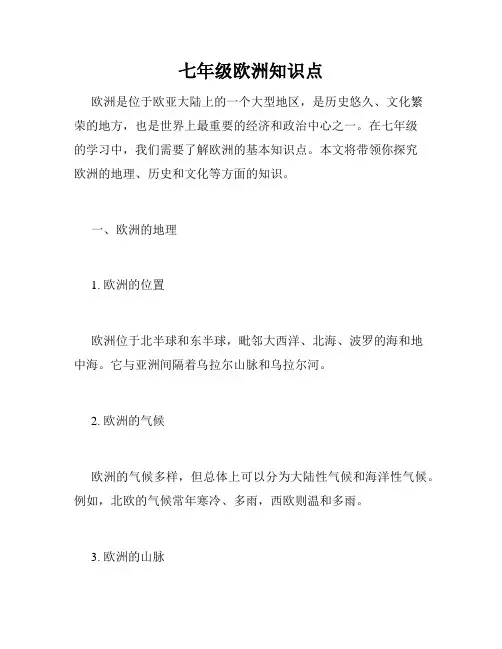
七年级欧洲知识点欧洲是位于欧亚大陆上的一个大型地区,是历史悠久、文化繁荣的地方,也是世界上最重要的经济和政治中心之一。
在七年级的学习中,我们需要了解欧洲的基本知识点。
本文将带领你探究欧洲的地理、历史和文化等方面的知识。
一、欧洲的地理1. 欧洲的位置欧洲位于北半球和东半球,毗邻大西洋、北海、波罗的海和地中海。
它与亚洲间隔着乌拉尔山脉和乌拉尔河。
2. 欧洲的气候欧洲的气候多样,但总体上可以分为大陆性气候和海洋性气候。
例如,北欧的气候常年寒冷、多雨,西欧则温和多雨。
3. 欧洲的山脉欧洲有阿尔卑斯山脉、喀尔巴阡山脉、比利牛斯山脉等众多山脉。
阿尔卑斯山脉是欧洲最高峰勃朗峰所在的地方。
4. 欧洲的河流欧洲的河流众多,其中最著名的是伏尔加河、多瑙河、罗讷河、塞纳河等。
多瑙河被誉为欧洲的母亲河。
二、欧洲的历史1. 欧洲的文明欧洲是许多文明的发源地,例如古希腊文明、罗马帝国、基督教文化等。
这些文化不仅在欧洲地区有着深远的影响,还对整个世界产生了巨大影响。
2. 中世纪以及文艺复兴中世纪是欧洲历史上的一个时期,该时期有骑士、贵族、教堂等元素,同时也是欧洲文化中的暗时期。
直到文艺复兴时期,欧洲逐渐走出了中世纪的阴影,开始了艺术、科学等领域的繁荣。
3. 欧洲两次世界大战在20世纪,欧洲发生了两次世界大战,给欧洲及整个世界带来了巨大的破坏和影响。
第二次世界大战之后,欧洲开始逐渐融合,在政治和经济上实现了一定的统一。
三、欧洲的文化1. 欧洲的宗教欧洲主要有天主教和东正教两种基督教教派,以及伊斯兰教、犹太教等宗教。
这些宗教不仅是欧洲人民的信仰,也是欧洲文化的重要组成部分。
2. 欧洲的音乐欧洲有着丰富多样的音乐文化,古典音乐、流行音乐等类型都有着独特的音乐风格和历史背景。
例如,奥地利的莫扎特是古典音乐的代表人物,英国的披头士则是流行音乐的代表。
3. 欧洲的艺术欧洲的艺术历史悠久,有着世界著名的绘画、雕塑等艺术作品。
例如,意大利的达·芬奇、米开朗基罗等都是欧洲艺术的代表人物。
一.细节知识点(一)Greek &Roman1.drama●Aeschylus埃斯基洛斯:Prometheus Bound被束缚的普罗米修斯,Persians波斯人,Agamennon●Sophcles索发克里斯:(tragic art)Oedipus the king, Electra,Antigone●Euripides欧里庇得斯:“problem plays”,Andromache,Medea,Trojan Women●Aristophanes阿里斯多芬尼斯:Frogs,Clouds,Wasps,Birds2.Historian●Herodotus:*“father of history”* from Greek to Persians*full of anecdotes and dialogues ,interesting●Thucydides: *younger than Herodotus *Athens to Sparta andAthens to Syracuse希拉库萨 *style is imagination and power*the greatest historian that ever lived3.philosophy and science●Pythagoras毕达哥拉斯: *bold thinker *believe everything isnumbers* scientific mathematics----point,line ,magnitude震级,surface,body,first proportion●Heracleitus赫拉克里克:*fire is the primary element ofuniverse*sayings: all is flux,nothing stationary/you cannot steptwice into the same river/fresh waters are ever flowing inupon you/ the sun is new every day.*believe mingling of opposites ,opposites produce harmony(二) Bibletranslation●Latin version:383-405AD by St .Jerome●English version:1382 John Wycliff(三)Middle ages/ Medieval1. AD 476 Roman power was gone2. after 1054 Church was divided into Roman Catholic and EasternOrthodox Church3.The Crusades: 1096-1291 last for about 200 years4.learning:● Charlemagne查理曼大帝:*western and central Europe*father of Europe .Emperor of Romans in 800*Carolingian Renaissance加洛林*encourage Christian religion and ancient learning by settingmonastery schools● Alfred the Great阿尔弗雷德大帝:*ruler of Anglo Saxon of Wessex*Encourage teacher and scholars , Wessex center of learning*Anglo Saxon chronicles英国编年史● St .Thomas Aquinas*Italian philosopher ,scholasticism经院哲学*Summa Contra Centiles , Summa Theologiae 《神学大全》*building a society of “God’s rule””God’s will”,Pope is“Christ’s plenipotentiary基督的全权代表” above secular rulers● Roger Bacon罗杰培根*a British monk ,one of the earliest advocates of experimentalscientific research and observation*works :Opus maius ,encyclopedia of the sciences of his time5.Literature●Beowulf :an Anglo Saxon epic● Song of Roland ,La Chanson de Gestes: French● Dante:the divine of comedy神曲 greatest poet of Italy●Geoffrey Chaucer 乔叟:English poet :canterbury tales坎特伯雷故事集,(first short story teller, first modern poet in Englishliterature )(四)Renaissance1.started in Florence and Venice, Italy2.heart of Renaissance philosophy is greatness of man ,humanism3.masterpieces :● Giovanni Boccaccio薄伽丘:Decameron十日谈(the greatestachievement of prose fiction 散文小说in the middle ages)● Francesco Petrarch彼德拉克:*discover Cicero’s Oration Oro Arochia,a Roman defense of poetry*Works: Canzoniers(lyrical), Africa,Metrical Epistles,OnContempt for the Worldly Life,On Solitude,Ecologues, The Letters●Giotto乔托:*forerunner of Renaissance,led the way to humanism,realistic depiction of space*works: Flight into Egypt ,Betrayal of Juda s●Giorgione乔尔乔捏:Tempesta , Sleeping Venus(use of colour schemes to unify picture and most revolutionary result in this sphere)●Leonardo da Vinci:*painter, sculptor, architect, musician, mathematician, engineer,inventor, anatomist, geologist, cartographer, botanist, and writer.*12 paintings 5000 books ,Renaissance man in the true sense of word.*Last Supper(most famous religious pictures), Mona Lisa(most portrait)●Michelangelo Buonarroti:* an Italian sculptor, painter, architect, poet, and engineer* David ,Sistine Chapel ,Dying Slave ,Moses●Raphael:Madonna(Virgin Mary)各种圣母画,school of Athens● Rabelais拉伯雷: French ,Gargantua and Pantagruel《巨人传》● Pleiade 七星诗社:French ,leader is Pirre de Ronsard(Sonnet PourHelene) ,发扬保卫法兰西语言●Cervantes塞万提斯:Spanish,Don Quixote 1062● Erasmus:Dutch, Renaissance humanist, Catholic priest, teacher,and theologian,Greek edition of New Testament ,Praise ofFolly《愚人颂》●Durer : German ,follower of Martin Lutherthe four horsemen of apocalypse 天启四骑士knight ,death and the devil●Thomas more:英国人,Utopia乌托邦,conclusion●Shakespeare:英国人Twelfth night ,As you like it ,Hamlet,Othello,King Lear ,Macbeth,Antony andCleopatra,Sonnets, King Henry 5,6二 .名词解释1.RenaissanceRenaissance is a period of western civilization between 14-17thcentury. The word Renaissance means revival .it also means therevival of interest in ancient Greek and Roman culture,whichstarted in Florence and Venice ,Italy . the heart of~is humanism.2 . Reformation~ was a 16th century religious movement as well as a socio-political movement ,which began with Martin Luther’s 95 theses in1517. The Reformation began as an attempt to reform the RomanCatholic Church.3.Middle ages :~is also called Medieval ,”the year of faith”* or the thousand-year period following the fall of the western roman empire in the 5thcentury .it came between ancient times and modern times .During thisperiod Germanic kingdom grew into nations such asEngland ,French ,Spain, Italy, Germany.4 . Feudalism~is a system of holding land in exchange for military service .the word~was derived from the Latin “feudum” , a grant of land.5 Catholic~Means” universal”. ~church was a highly centralized and disciplinedinternational religious organization .in the middle ages ,almostevery Europeans belonged to it.6. old testament~is one of the two parts of the Bible ,which is about the God and the laws of God. Testament means agreement—the agreement between Godand man.7. Pentateuch 摩西五书The oldest first five parts of the Bible includingGenesis ,Exodus,Leviticus, Numbers, Deuteronomy8. doric :one of Greek architecture styles,~is also called masculine style .it’s sturdy坚定的,powerful,severelooking ,showing sense ofproportions and numbers.Ionic:feminine style graceful and elegant,showing wealth of ornament装饰三.问答1. What happened in Western Europe after the decline of the Roman Empire?After the Roman Empire lost its predominance优势, a great many Germanic Kingdoms began to grow into the nations know as England, France, Italy, and Germany in its place. These nations of Western Europe were in the scene of frequent wars and invasions. The political unity had given way to widespread destruction and confusion. Hunger and disease killed many lives and village fell into ruin and great areas of land lay waste. There was no central government to keep the order. The only organization that seemed to unite Europe was the Christian church. Christianity was almost the all and the one of Medieval lives in western Europe and took lead in politics, law, art, and learning for hundreds years.2. What were the cultural characteristics of the period from 500 to 1000?Above all, the cultural characters of this period were the heritage and achievement of Roman culture and the emergence of Hebrew and Gothic culture.3.What made Italy the birthplace of the Renaissance?Because of its geographical position, foreign trade developed early in Italy. This brought Italy into contact with other cultures and gave rise to urban economy and helped Italy accumulate wealth which was an essential factor for the flowering of art and literature.For two centuries beginning from the late 15th century, Florence was the golden city which gave birth to a whole generation of poets, scholars, artists and sculptors. There was in Florence a revival of interest in classical learning and rising of humanist ideas.And to spread the new ideas, libraries and academies were founded.In the 15th century printing was invented and helped to spread humanist ideas.4.How did Italian Renaissance art and architecture break away from medieval tr aditions?The Italian Renaissance art and architecture radically broke away from the medi eval methods of representing the visible pared with the latter,the fo rmer has the following distinct features:⑴Art broke away from the domination of church and artist who used to be craftsmen commissioned by the church became a separate strata doing noble and crea tive work⑵Themes of painting and architecture changed from purely celestial realm focusing on the stories of the Bible,of God and Mary to an appreciation of all a spects of nature and man;⑶The artists studied the ruins of Roman and Greek temples and put many of theprinciples of ancient civilization into their works;⑷Artists introduced in their works scientific theories of anatomy and perspective.欢迎您的下载,资料仅供参考!致力为企业和个人提供合同协议,策划案计划书,学习资料等等打造全网一站式需求⑸。
初一欧洲知识点归纳总结欧洲位于东北半球,是世界上面积第二小的大洲,也是人口第三多的大洲。
它以丰富的历史、文化和风景而闻名于世。
以下是初一学生应该了解的欧洲知识点的归纳总结:地理位置:欧洲位于亚洲大陆的西面,地形以高原为主,但还有许多河流穿越其中,如著名的伏尔加河、多瑙河和塞纳河等。
此外,还有许多山脉,如阿尔卑斯山脉、喀尔巴阡山脉和泰特罗山脉等。
国家与首都:欧洲有50多个独立国家,每个国家都有自己的首都。
以下是一些国家及其首都的例子:- 法国:首都为巴黎- 德国:首都为柏林- 英国:首都为伦敦- 西班牙:首都为马德里- 俄罗斯:首都为莫斯科历史与文化:- 古希腊:古希腊文明对欧洲和世界文化产生了巨大影响。
古希腊建立了民主政体,同时还有许多著名的哲学家、数学家和文学家。
- 罗马帝国:古罗马帝国是古代欧洲最伟大的帝国之一。
它的法律、建筑和文化对整个欧洲产生了深远影响,留下了许多著名的建筑物,如罗马斗兽场和罗马水道等。
- 文艺复兴:文艺复兴是欧洲历史上的一个重要时期,它标志着对古代文化的重新研究和赞赏。
这个时期涌现出了许多伟大的艺术家和科学家,如达·芬奇、米开朗基罗和伽利略等。
语言:欧洲有许多不同的语言,每个国家通常都有自己独特的语言。
以下是一些欧洲常见的语言:- 英语:是世界上最为广泛使用的语言之一,在欧洲和其他许多国家都被广泛使用。
- 西班牙语:主要在西班牙和拉丁美洲国家使用,也在欧洲的许多地区被讲使用。
- 法语:是很多国际组织的官方语言之一,同时也是许多欧洲国家的官方语言之一。
旅游景点:欧洲拥有许多著名的旅游景点,吸引着来自世界各地的游客。
以下是一些著名的景点:- 埃菲尔铁塔(法国,巴黎):巴黎的象征之一,是世界上最著名的建筑物之一。
- 大本钟(英国,伦敦):位于伦敦议会广场的著名钟楼,是英国标志性建筑物之一。
- 罗马斗兽场(意大利,罗马):古罗马时期的著名建筑,是世界上最大的古代斗兽场之一。
第二单元古代欧洲文明基础知识第四课希腊城邦和亚历山大帝国(古代希腊文明)一、希腊城邦1.地理范围:希腊半岛(主体),爱琴海诸岛小亚细亚西部,黑海沿岸,意大利南部,西西里岛2.地理环境1)表现:①多山,环海,多岛屿等②平原小,耕地少2)影响:①政治:“小国寡民”(城邦林立)②经济:航海业,海外贸易3.希腊早期文明:爱琴文明1)时间:公元前2000年—公元前1200年2)代表:克里特文明,迈锡尼文明3)荷马时代(落后)4.希腊城邦国家1)(重新)兴起:前8世纪2)城邦国家含义:以城市(市镇)为中心,周围农村组成小国(奴隶制)3)特点:“小国寡民”4)规模:最大:斯巴达 8400平方千米;最小:几百人5)城邦居民:公民,非公民①公民:成年男性公民享有政治权利(参加公民大会)公民占有土地参军打仗义务参加宗教活动,节庆演出,文体竞赛等②非公民:外邦人:自由,没有政治权利,不占土地奴隶:没有自由,不享有政治权利③关系:统治者与被统治者关系,界限分别,难以转化6)代表:斯巴达:内陆,尚武军事化雅典:民主政治,航海业,海上贸易二、雅典的民主政治1.位置:希腊中部(临海,航海业,海外贸易)2.民主政治发展1)梭伦改革:公元前594年;设四百人议事会2)克利斯提尼改革:前509年五百人议事会3)伯里克利改革陶片放逐法3.全盛:1)时间:前五世纪中后期2)执政官:伯里克利3)表现:经济发达,国势强盛;奴隶制民主政治达到巅峰4.雅典民主政治1)高峰:前五世纪中后期伯里克利执政2)内容:①扩大公民权利公职人员抽签产生(选举)②十个主席团轮流主政(抽签产生)③国家最高权力机构:公民大会(立法,司法等职能)④建立津贴制度(贫穷公民)3)局限性:①只有全体成年男性公民享有政治权利②外邦人,妇女奴隶没有政治权利三、亚历山大帝国1.兴起:前四世纪希腊北部,马其顿国兴起,控制希腊2.亚历山大东征(前344年)1)伊苏斯之战①时间:公元前334年②双方:亚历山大 3.5万;大流士三世 10万③地点:叙利亚,伊苏斯平原④结果:亚历山大出奇制胜2)南下沿地中海东岸占领埃及3)灭波斯①前331年,回师两河流域再败波斯②前330年灭波斯4)最远到达印度河流域5)结果:①历时10年建立庞大帝国②版图:西:希娜东:印度河流域北:中亚南:埃及6)称誉:亚历山大帝国(国家名称)亚历山大帝(最高统治者)3.影响1)消极:①给东方人民带来巨大灾难②掠夺了东方世界的无数财产2)积极:①促进了东西方文化的大交汇②加强了东西方之间的经济联系和贸易往来③建立新城,使其成为新的文化中心第五课罗马城邦和罗马帝国(古代罗马文明)一、罗马城邦和罗马共和国1. 地理环境1)地中海中部,三面临海(意大利半岛,亚平宁半岛)2)山地众多,有利于畜牧业3)西部河流纵横,土地肥沃,有利于农业2. 城邦兴起1)时间:公元前1000年2)罗马城邦兴起①时间:公元前8世纪②地点:意大利半岛中部 台伯河畔3. 罗马共和国1)建立:公元前509年2)罗马统治的特点①最高决策权:元老院(300名贵族)②两个执政官主持日常事务③公民大会:形式最高权力机关④设立两名保民官(平民选出)有权否决决议⑤颁布《十二铜表法》3)统一:前3世纪征服(统一)意大利半岛 4)扩张:①布匿战争时间:前246-公元前196年双方:罗马共和国 迦太基(三次)结果:成为西地中海霸主②前2世纪征服东地中海,成为地中海霸主③掠夺大量奴隶,成为主要生产者5)衰落:斯巴达克起义打击①斯巴达克:角斗士奴隶②前73年起义,声势浩大③结果:沉重打击罗马统治,最终被镇压二、罗马帝国1. 建立1)公元前49年,凯撒夺权(独裁者)2)前44年,凯撒被刺3)前31年,屋大维夺权4)前21年,创“元首制”标志罗马帝国建立2. 屋大维统治:采取措施,解决矛盾,巩固地位,促进发展3. 强盛1)2世纪 黄金时期时间:公元前450年名称由来:法律条刻在十二块青铜板上内容:涉及诉讼,所有权,债务权以及宗教法等影响:量刑定罪有文字依据,一定程度遏制贵族2)版图:地跨欧亚非三洲地中海成为内湖三、罗马帝国的衰亡1.原因1)内因:①3世纪帝国统治经济大危机②统治者争斗,人民起义,农业工商业衰落,民生凋敝2)外因:375年,北方日耳曼人大举入侵(蛮族)3)实质:奴隶制危机2.分裂:4世纪末(395年)东西罗马3.西罗马帝国灭亡:476年第六课希腊罗马文化一、文学和雕塑1.总体成就:神话,文学,艺术,哲学,科学,史学,法学,体育2.神话:希腊神话特点:神人同形同性3.文学:《荷马史诗》1)作者:荷马2)《伊利五特》《奥德赛》3)意义:了解早期希腊社会的重要文献4.雕塑1)希腊人物雕塑达到完美境界2)代表作奥林匹克亚神庙宙斯像(七大奇迹之一)《掷铁饼者》二、建筑1.影响:对后世产生深远影响2.希腊建筑:1)神庙建筑艺术2)特点:四周廊柱环绕柱子有粗有细3)代表:帕特农神庙(奉祀雅典娜的神庙)3.罗马建筑:1)特点:吸收希腊建筑特点创新柱子拱形穹顶为主坚固结实华丽宏伟2)代表:①罗马大竞技场(可容纳万人)②引水道工程:高架引水渠③凯旋门④万神庙三、哲学和法学1.希腊哲学1)德谟克利特:提出“原子论”认为:宇宙万物由微小原子构成2)苏格拉底①开始思考人类社会②探究人的灵魂,美德,幸福等③求和最好办法是系统的问和答④主张人应该“认识你自己”(内心世界)3)亚里士多德①百科全书式的学者②对许多学科有贡献③创立逻辑学等学科体系(物理学,植物学,动物学等)④名言:吾爱吾师,吾更爱真理4)阿基米德①浮力定律②杠杆定律2.罗马法学1)地位:罗马人最伟大的成就之一2)源头:《十二铜表法》(前450年)3)完整罗马法体系①法学家对法律广泛论证②万民法③经济法④众多法律概念四、公历1.来源:古埃及人的太阳历2.基础:凯撒《儒略历》内容:每逢能被四整除的那一年为闰年,在2月份增加一天3.4世纪:成为基督教历法4.16世纪格列高利历二、易混易错、知识点拨与拓展1、【易错易混】1、古代罗马时期分为罗马共和国时期和罗马帝国统治时期。
欧洲文化知识点复习欧洲文化是指欧洲大陆上各个国家和地区的文化特点和传统。
它是世界上最为繁荣和多样化的文化之一,涵盖了广泛的领域,包括艺术、音乐、文学、哲学、宗教、建筑、风俗习惯等等。
在本文中,我们将对欧洲文化的一些重要知识点进行复习。
一、欧洲文化的历史背景欧洲文化的起源可以追溯到古希腊和古罗马时期。
古希腊是西方文明的发源地,它对欧洲文化产生了深远影响。
古希腊的哲学、政治制度、艺术和体育等方面的成就,对后世产生了重要影响。
古罗马帝国则在政治、法律、军事和城市规划等方面有着重要贡献。
中世纪是欧洲文化发展的关键时期。
基督教在欧洲传播开来,成为欧洲的主要宗教。
教会在中世纪拥有巨大的权力,对欧洲文化的塑造起到了重要作用。
此外,中世纪还涌现出许多伟大的文化和学术中心,如巴黎大学、牛津大学等。
文艺复兴是欧洲文化发展的重要阶段。
它标志着对古典文化的重新发现和研究。
文艺复兴时期的艺术家和学者对古希腊和古罗马的文化进行了广泛的研究和借鉴,推动了欧洲文化的再次繁荣。
文艺复兴时期的一些重要人物包括达·芬奇、米开朗基罗、莎士比亚等。
二、欧洲文化的艺术与文学1. 文艺复兴时期的艺术:文艺复兴时期的艺术以人文主义为基础,注重对人体的研究和描绘。
达·芬奇的《蒙娜丽莎》和《最后的晚餐》是文艺复兴时期最著名的艺术作品之一。
米开朗基罗的雕塑作品《大卫》和壁画《创世纪》也是文艺复兴时期的代表作品。
2. 巴洛克艺术:巴洛克艺术是17世纪欧洲的一种艺术风格,以宏伟、夸张和复杂的风格特点而闻名。
巴洛克时期的音乐家巴赫和画家伦勃朗都是巴洛克艺术的代表人物。
3. 浪漫主义文学:19世纪的欧洲文学以浪漫主义为主导,强调情感和个人内心体验。
歌德的《浮士德》和雨果的《悲惨世界》是浪漫主义文学的经典作品。
三、欧洲文化的音乐与舞蹈1. 古典音乐:欧洲是古典音乐的发源地。
贝多芬、莫扎特、巴赫等作曲家的音乐作品对世界音乐产生了重要影响。
古典音乐的形式包括交响乐、协奏曲、室内乐等。
《欧洲文化入门》知识点笔记1、There are many elements constituting(组成) European Culture.2、There are two major elements:Greco-Roman element and Judeo-Christian element.3、The richness(丰富性) of European Culture was created by Greco-Roman element and Judeo-Christian element.第一章1、The 5th century closed with civil war between Athens and Sparta.2、The economy of Athens rested on(依赖) an immense(无限的)amount of slave labour.3、Olympus mount, Revived in 1896(当代奥运会)4、Ancient Greece(古希腊)’s epics was created by Homer.5、They events of Homer’s own time. (错)(They are not about events of Homer’s own time, probably in the period 1200-1100 B.C.)6、The Homer’s epics consisted of Iliad and Odyssey.7、Agamemnon,Hector, Achilles are in Iliad.8、Odysseus and Penelope are in Odyssey.9、Odyssey(对其作品产生影响)—→James Joyoe’s Ulysses(描述一天的生活) In the 20th century.10、Drama in Ancient Greece was floured in the 5th century B.C.11、三大悲剧大师① Aeschylus《Prometheus Bound》—→模仿式作品Shelly《Prometheus Unbound》② Sophocles(之首)《Oedipus the King》—→ Freud’s “the Oedipus complex” (恋母情结)—→ David Herbert Lawrence’s《Sons and lovers》(劳伦斯)447页③ EuripidesA.《Trojan Women》B.He is the first writer of “problem plays”(社会问题剧) 在肖伯纳手中达到高潮,属于存在主义戏剧的人物C.Elizabeth Browning called him “Euripides human”(一个纯粹的人)D.Realism can be traced back(追溯到) to the Ancient Greece.To be specific(具体来说),Euripides.12、The only representative of Greek comedy is Aristophanes. 18页Aristophanes writes about nature. —→浪漫主义湖畔派(The lakers)华兹华兹(新古典主义代表作家《格列夫游记》《大人国小人国》《温和的提议》用讽刺的写作手法)13、History (Historical writing)史学创作※“Father of History” —→ Herodotus —→ war(between Greeks and Persians)This war is called Peleponicion wars. 博罗奔泥撒,3只是陈述史实,并没有得出理论。
初一欧洲知识点归纳总结初一学生在学习欧洲知识点时,通常需要掌握以下几个方面的内容:1. 地理知识:- 欧洲的地理位置:欧洲位于北半球,东临亚洲,西临大西洋,南临地中海。
- 欧洲的主要国家:英国、法国、德国、意大利等。
- 欧洲的地形地貌:阿尔卑斯山脉、多瑙河、莱茵河等。
2. 历史知识:- 欧洲的古代文明:古希腊、古罗马等。
- 中世纪的欧洲:封建制度、宗教改革等。
- 近现代欧洲:工业革命、两次世界大战等。
3. 文化知识:- 欧洲的文学艺术:文艺复兴、印象派等。
- 欧洲的建筑风格:哥特式、巴洛克式等。
- 欧洲的节日和传统:圣诞节、复活节等。
4. 政治经济:- 欧洲的政体:君主制、共和制等。
- 欧洲的经济:欧盟、欧元等。
- 欧洲的国际关系:欧盟与其他国家的关系等。
教材解读:- 教材通常会按照时间线或主题来组织内容,学生需要理解每个部分的核心概念和重要事件。
易错知识点归纳:- 地理名称的拼写错误。
- 历史事件的年代和顺序混淆。
- 文化作品的作者和时期对应错误。
经典例题及详细解题步骤:- 例题:描述文艺复兴时期的主要特点。
解题步骤:1. 定义文艺复兴是什么。
2. 列举文艺复兴时期的主要艺术家和作品。
3. 描述文艺复兴对欧洲文化和思想的影响。
资料形式多样化:- 地图和图表:帮助学生更好地理解地理和政治经济结构。
- 视频和纪录片:提供生动的历史场景和文化背景。
- 互动软件和在线课程:允许学生通过游戏和练习来加深理解。
- 思维导图和时间线:帮助学生整理和记忆复杂的信息。
通过上述方法,学生可以更全面、深入地理解欧洲的知识点,同时多样化的学习资料也有助于提高他们的学习兴趣和自主学习能力。
第三章1、the Middle ages名词解释In European history, the thousand-year period following the fall of the Western Roman Empire in the fifth century is called the Middle Ages.2、The middle ages is so called because it came between ancient times and modern times. To be specific (具体说来), from the 5th century to 15th century.3、The transitional (过渡时期) period is called the middle ages, between ancient times and modern times.4、The transitional (过渡时期) period is called the 17th century, between the middle ages and modern times.5、In 476 A.D. a Germanic (日耳曼) general killed the last Roman emperor and took control of the government. 西罗马476灭,东罗马1653年灭6、Feudalism名词解释Feudalism in Europe was mainly a system of land holding (土地所有) — a system of holding land in exchange for military service (军事力量)。
The word “feudalism” was derived (来源) from the Latin “feudum”,a grant (许可的) of land.7、fiefs(次划分)名词解释In Feudalism, the ruler of the government redivided the large lands into small pieces to be given to chancellors (有功的大臣) or soldiers as a reward (奖赏) for their service. The subdivisions were called fiefs.8、vassals (占有fiefs的人)名词解释In Feudalism, the ruler of the government redivided the large lands intosmall pieces to be given to chancellors (有功的大臣) or soldiers as a reward (奖赏) for their service. The subdivisions were called fiefs. The owners of the fiefs was call vassals.9、code of chivalry (骑士制度)名词解释As a knight, he were pledged to protect the weak, to fight for the church,to be loyal to his lord and to respect women of noble birth. These rules were known as code of chivalry, from which the western idea of good manners developed.10、dubbing (骑士头衔加冕仪式)名词解释After a knight was successful in his trained and tournaments, there was always a special ceremony (选择) to award him with a title, knight. This special ceremony is called dubbing.11、knight trained for war by fighting each other in mock battles called tournaments.(模拟战场)12、The crusades ended up with the victory of Moslems.(穆斯林)13、The Manor (领地所有制)名词解释The centre of medieval life under feudalism was the manor. Manors were founded on the fiefs of the lords (农场主)。
By the twelfth century manor houses were made of stone and designed as fortresses. They came to be called castles.14、After 1054, the church was divided into the Roman Catholic Church and the Eastern Orthodox Church.15、 The Catholic Church made Latin the official language and helped to preserve (保留) and pass on the heritage (传统) of the Roman Empire.16、The word “catholic”,meant “universal”。
(广泛的,无处不在的)17、St. Jerome, who translated into Latin both Old and New Testament from the Hebrew and Greek originals. Vulgate (拉丁语圣经)18、Early Monasticism (早期修道院制)名词解释Between 300 and 500 A.D., many men withdrew from (放弃了) worldly contacts to deserts and lonely places. This movement developed into the establishment of monasteries (男) and convents (女) for monks and nuns. Some of the hermits (隐士) were great scholars known as “Father of the Church”, whose work is generally considered orthodox.(东正教)19、Augustine —→ “Confession” (坦白) and “The City of God” (上帝之都)20、St. Benedict —→ founded Benedictine Rule about 529 A.D. (专门给清修的人制定的法律)21、The Inquisition (问讯厅) to stamp out so-called heresy.异教22、The most important of all courses was Jerusalem. (耶路撒冷)23、Crusades went on about 200 years.24、There were altogether eight chief Crusades.25、 (结束) By 1291 the Moslems (穆斯林) had taken over the last Christian stronghold. They won the crusades and ruled all the territory in Palestine that the Crusaders had fought to control.26、Carolingian Renaissance名词解释Carolingian Renaissance is derived from Charlemagne‘s name in Latin,Carolus. The most interesting facet (一面) of this rather minor renaissance is the spectacle (有见解) of Frankish or Germanic state reaching out to assimilate (吸收) the riches of the Roman Classical and the Christianized Hebraic culture.27、Roger Bacon‘s work wa s the Opus maius.28、National Epics(民族史诗运动)名词解释The epic was the product of the Heroic Age. It was an important and mostlyused form in ancient literature. “National epic” refers to the epic written in vernacular languages—that is, the languages of various national states (民族国家) that came into being in the Middle Ages. Literary works were no longer all written in Latin. It was the starting point of a gradual transition of European literature from Latin culture to a culture that was the combination of a variety of national characteristics.29、Chaucer (乔叟) 的诗歌特点:① power of observation (观察)② piercing irony (敏锐的讽刺) ③ sense of humour ④ warm humanity (温暖的人性)与狄更斯相似30、Gothic名词解释① The Gothic style started in France and quickly spread through all parts of Western Europe.② It lasted from the mid-12th to the end of 15th century and, in some areas,into the 16th. More churches were built in this manner than in any other style in history.③ The Gothic was an outgrowth (丰富与发展) of the Romanesque.(罗马式)31、The Canterbury Tales:① The Canterbury Tales was written by Chaucer.② Chaucer introduced French and Italy writing the English native alliterative verse.(压头韵)③ Both Chaucer and The Canterbury Tales are the best representative of the middle English.论述简答一、In the middle ages, what cultures began to merge (融合)?答:Classical, Hebrew and Gothic heritages merged (文化融合)。